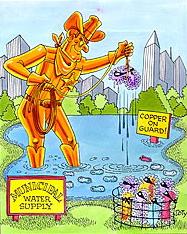Copper Joins Fight Against Terrorism
 High-resolution version of this photo.
High-resolution version of this photo.The advent of worldwide terror networks intent on attacking the USA has prompted concerns over the possibility of terrorists contaminating our water supplies with dangerous biological agents.
Copper may one day prove to be an important weapon in our nation's arsenal against these kinds of potential terrorist attacks. Researchers are working on a device that would use copper electrodes to detect minute quantities of bacteria in large-volume water sources, such as municipal reservoirs.
Under current practice, finding contaminants in large bodies of water is like looking for a needle in a haystack. Since it is impossible to examine every drop of water, engineers do spot-checks instead.
However, Texas A&M University microbiologist Suresh Pillai , and mechanical engineer , Ali Beskok may have found a way to solve this dilemma by attract channeling large quantities of five liters of recycled water an hour through hundreds of tiny tubes lined with positively charged copper electrodes. In theory, these electrodes should attract the bacteria, which are naturally negatively charged, corralling them into a concentrated sample that could be easily tested.
The size of each tube - a quarter of a millimeter wide - ensures that any microbes present will pass close enough to the copper electrodes to adhere to it. As a result, bacteria and viruses from dozens of liters of water could be easily corralled into a sample the size of a thimble.
Their work has attracted financial support from NASA, whose $89,000 grant will be used to project develop a prototype of the water-monitoring device that could be used on long space flights. Astronauts must monitor their water supply constantly when they are in space; an easier testing process would free up their time for more important tasks.
The research team also received funding from the state of Texas to develop a drinking water prototype and the El Paso Water Utility has agreed to field field-test the device on its water distribution system.
Pending if tests prove successful , Pillai and Beskok are hoping NASA will provide more additional funding for a more comprehensive study. Cu
Also in this Issue:
- Recycled Copper Keeps Its Value
- Got Hot Water?
- Preventing Waterborne Disease
- Copper Joins Fight Against Terrorism
